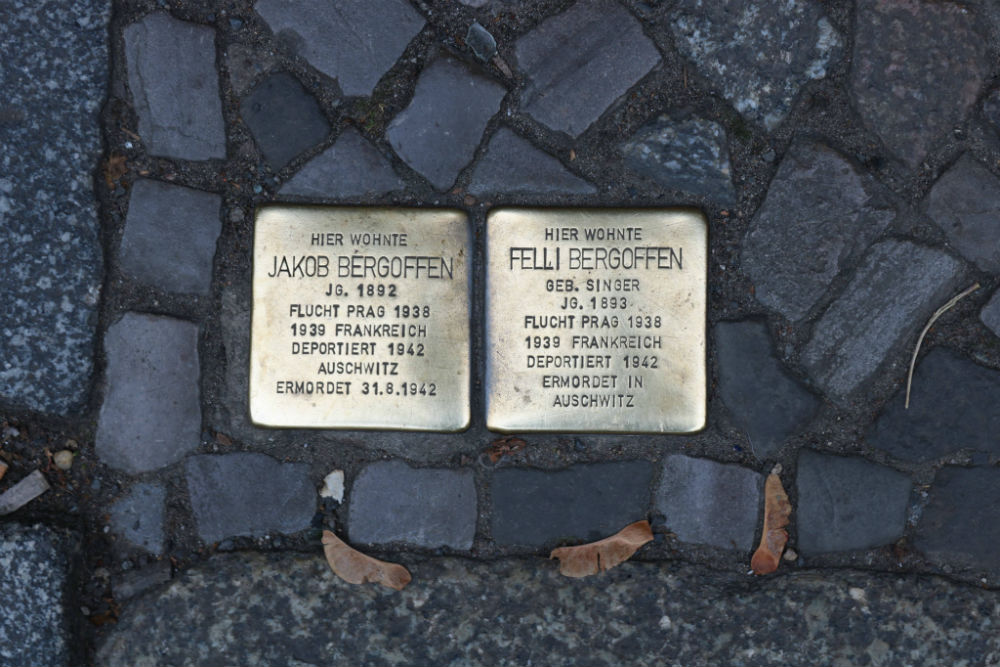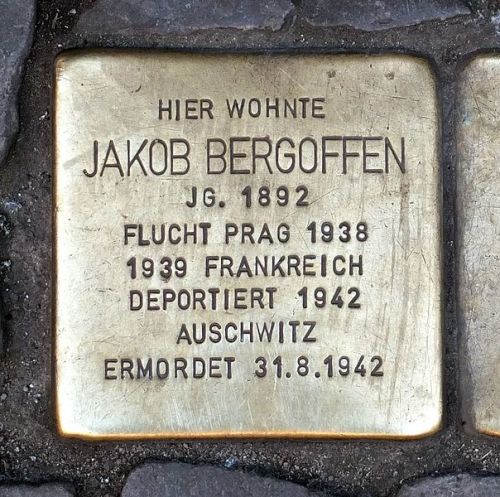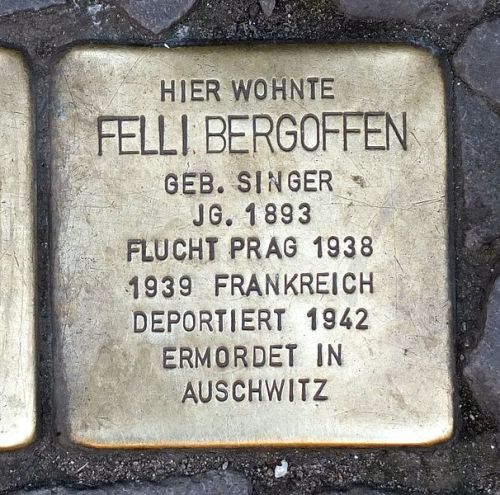Stumbling Stones Sophienstraße 6
These small brass memorial plaques (Stolpersteine or stumbling stones) commemorate:
* Jakob Bergoffen, born 1892, fled to Prague 1938, 1939 France, deported 1942 Auschwitz, murdered 31 August 1942.
* Felli Bergoffen née Singer, born 1893, fled to Prague 1938, 1939 France, deported 1942, murdered in Auschwitz.
Jakob Bergoffen married Felli Singer, and they had 2 sons, Max (1921) and Leo (1922). The family lived in a spacious apartment in the courtyard VIII / stairway H of the building complex Hackescher Hof in the Rosenthaler Str. 40/41. Together Jakob and Felli ran a well-known paint shop in Oraienburger Strasse 12. After 1933, with customers boycotting the shop, the business declined, and they were forced to sell it -- at a greatly reduced price, as was usual. With harrassment and assaults increasing, they then decided to leave Germany. They went to Prague in 1938, then the parents and Leo managed to get to France the next year. Max stayed, then went to England with other refugees. There he joined the Air Force. After the war he emigrated to the US.
Jakob, Felli, and Leo stayed in Angers, Loire, France safely for several years, until they were arrested and deported from Camp Drancy to Auschwitz labor camp – first, Jakob and Felli in July 1942 with 800 others, and then Leo in September. Jakob was murdered in August; the date of Felli’s death is not known. Leo worked on behalf of the Nazis, surviving until liberation, and he returned to France, where he lived into his 90s.
"Stolpersteine" is an art project for Europe by Gunter Demnig to commemorate victims of National Socialism (Nazism). Stolpersteine (stumbling stones) are small, 10x10cm brass plaques placed in the pavement in front of the last voluntary residence of (mostly Jewish) victims who were murdered by the Nazis. Each plaque is engraved with the victim’s name, date of birth, and place (mostly a concentration camp) and date of death. By doing this, Gunter Demnig gives an individual memorial to each victim. One stone, one name, one person. He cites the Talmud: "A human being is forgotten only when his or her name is forgotten."
Do you have more information about this location? Inform us!
Source
- Text: Fedor de Vries & Anne Palmer
- Photos: Christian Heller Jensen (1)
- Photos: Axel Mauruszat (2)
- Stolpersteine in Berlin: Bergoffen
- Avrillémag, Oct-Nov 2016: Leo Bergoffen
- Stolpersteine.eu
Nearby
Museum
- Anne Frank Centre - Berlin
- Otto Weidt’s Workshop for the Blind - Berlin
- German Historical Museum (Zeughaus Berlin) - Berlin
Point of interest
- Bullet Impacts Große Hamburger Straße 28 - Berlin
- Former Gestapo Office Berlin - Berlin
- New Synagogue - Berlin
Monument
- Memorial Jakob van Hoddis - Berlin
- Memorial Selmar Kaufmann - Berlin-Mitte
- Memorial Jewish Boys’ School - Berlin
Cemetery
- German War Graves Dorotheenstädtischer Friedhof - Berlin
- Jewish Cemetery Schönhauser Allee - Berlin
- Mass Grave Germans Domfriedhof I - Berlin
Remembrance Stone
- Stumbling Stones Sophienstraße 5 - Berlin-Mitte
- Stumbling Stones Rosenthaler Straße 32 - Berlin-Mitte
- Stumbling Stones Rosenthaler Straße 48 - Berlin-Mitte







